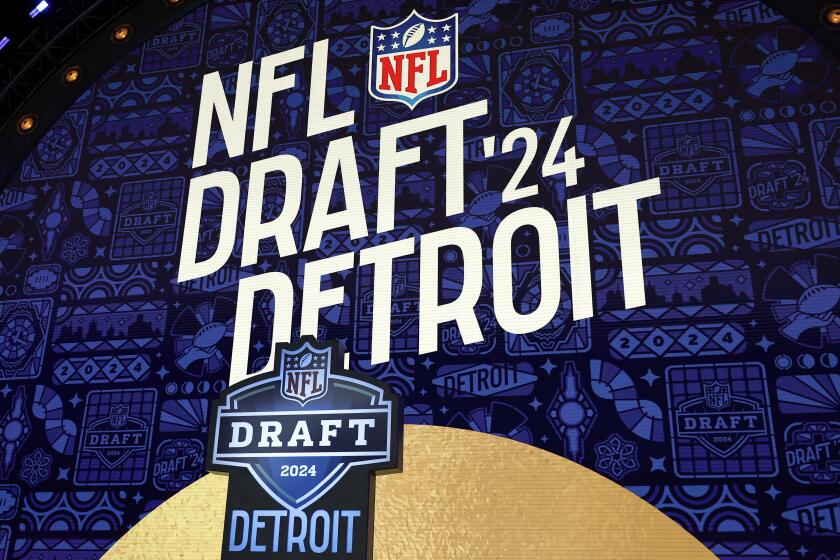A Place Where Pink Has Special Meaning
The hot-pink toilet seat covers imprinted with the Hawkeye football mascot sold out weeks ago. Gone, too, are the blush-colored sun visors, the ladies’ rose-toned underwear, the mauve-stained coffee cups and the salmon-tinted baby clothes.
But there are plenty of T-shirts for football fans in bubble-gum hues, with slogans such as “Locker Room Defense Fund” and “Give That Academia Nut Her Pink Slip.”
The demand for all things pink has soared after an associate law professor at the University of Iowa petitioned school officials to repaint the all-pink visitor’s locker room at Kinnick Stadium.
Jill Gaulding objected to the color scheme, she said, because it sent a misogynistic message and represented “a serious obstacle to gender equity on campus.” Hawkeye fans reacted by snapping up pink merchandise and sending hundreds of e-mails -- many of them anonymous, some of them downright nasty.
For decades, to the annoyance of some visiting teams, players have donned cleats and slipped on jock straps in a room painted the color of cotton candy.
Initially, the locker room was considered a sports oddity in this town, about 30 miles south of Cedar Rapids. But Hawkeye fans have come to regard the pink room as a treasured tradition.
When the university finished new locker rooms this year as part of an $86.8-million renovation of Kinnick Stadium, the school found ways to make the visitor’s side even more Barbie-esque. It didn’t choose simple pink. The school picked “Innocence” for the walls and “Dusty Rose” for the toilets and urinals.
Though the home team changes in a locker room decorated in the Hawkeye colors of gold and black, nearly every inch inside the visitor’s area looks like it was coated with Pepto-Bismol.
The ceramic tiles in the shower room are pink. So are the bathroom sinks, the interior of the equipment room, and the open metal lockers that hold players’ uniforms. The carpet is covered in delicate pink and gray flowers. Even the ceiling tiles have a subtle hint of color.
The only prominent thing not pink are the light bulbs.
“I teach discrimination law, and this is not a good precedent for anyone to set,” said Gaulding, 39. “What I object to are sexist jokes paid for by my employer, a public institution.”
Gaulding and her supporters have received an onslaught of e-mails from angry Iowa fans around the world. “The world will be a better place when you die,” one wrote. Another wrote that, “Maybe we should waste taxpayer money and repaint it lavender, just to appease you.”
University President David J. Skorton tried to end the quarrel -- he said the pink locker room would stay.
Gaulding has refused to drop her crusade. She has talked with friends and residents to gather support. She’s also responding to each e-mail, no matter how surly the writer. She’s answered several hundred so far.
“Iowa has no other major-league professional sports, so the Hawkeyes have a cult-like following that is incredibly superstitious,” said Ted Habte-Gabr, of the Los Angeles branch of the Iowa Alumni Assn. “You don’t do anything to jinx the team, no matter how ridiculous it might seem.”
Former University of Iowa Coach John Hayden Fry had the visitors’ locker room painted pink in the early 1980s to get a psychological edge over other teams. Armed with cans of pastel-pink paint, the stadium’s staff sought to create a soothing and calming environment.
Over the years, as the Hawkeyes became increasingly successful, some began to attribute it to the pink curse.
“They have a pretty good home-field record going on right now, so it may do something,” University of Illinois Coach Ron Zook told reporters before the two teams faced each other this month. (The Hawkeyes beat the Fighting Illini, 35-7.)
Such superstitions both amuse and exasperate Gaulding, a devoted Hawkeye fan who regularly holds tailgate parties for friends and neighbors.
She and her husband, Marc Light, 39, an assistant professor who teaches in the linguistics department and the School of Library and Information Science, and their two young daughters moved to Iowa City in the summer of 2002. They bought season tickets to the Hawkeyes before they unpacked all their boxes.
Gaulding said she first learned about the pink decor after a local paper wrote about the improved color scheme in the new visitors’ locker room. She brought up the subject with a co-worker, who expressed concern that the decor sent an anti-feminist and homophobic message.
So Gaulding, an expert on the psychological effects of bias, decided to take on the cause.
In early September, she wrote to the school’s Provost office and its Office for Diversity and spoke with the school’s athletic department. She explained how the unconscious brain picks up on stereotypes; most people saw the pink locker room as a way to call rival teams “girls and sissies,” which “reinforces sexism and homophobia.”
Gaulding and others then voiced their concerns at a public hearing held on campus to review NCAA certification issues.
In the weeks that followed, local shops and roadside vendors began hawking dozens of pink items to protest the complaints. Sales have boomed, particularly on weekends with home games, said retailer Ron Christensen, owner of Game Day Iowa.
“People are buying this stuff to make light of the situation,” Christensen said. “It’s unthinkable to change such a tradition.”
Before a recent game against Indiana University, James C. Darrel -- who stands 6-feet-1 and weighs nearly 270 pounds -- grabbed one of the “Pink Slip” T-shirts from a vendor and pulled it on. His biceps, the size of grapefruits, strained the seams. His stomach stretched the letters so they were almost unreadable.
“Thank God my father can’t see me in this,” Darrel, a 24-year-old mechanic from the Des Moines area, said with a grin.
In the meantime, the e-mails continue to flood Gaulding’s in-box. She spends at least a couple hours each day writing back.
“If I can get one person to change their mind, this will have been worth it,” Gaulding said.
Recently, she received a note from Ken Knickrehm of Lombard, Ill., who suggested she was simply trying to get her name in the newspapers. “The problem with feminists is they have no sense of humor ... lighten up sweetie,” he wrote.
Gaulding responded: “I have to disagree with you about my sense of humor, though I am not sure I could prove to you that I have a good one, beyond the fact that I have been cheerfully answering hate mail. That takes a sense of humor, believe me.”
Over e-mail, the pair discussed gender equality. The tone of the conversation shifted from hostile mockery to calm reflection.
“It may seem unlikely, but in fact scientists tell us that these sorts of put-downs and stereotypes get into our (unconscious) brains and cause us to act in a biased way, even when we don’t intend to,” Gaulding wrote.
Knickrehm replied: “As a father of two very young girls, I do take the issue of sex discrimination seriously. My hope is they can grow up to a world where it is a complete nonissue.”
In the end, though, Gaulding couldn’t sway Knickrehm.
But, Knickrehm wrote, “I have the deepest respect that you took the time to write to me. I almost feel sorry for your opposition, considering that you wrote a well-reasoned and thought-out response to a knucklehead like me.”
After sending a note of thanks, Gaulding moved on.
“I can’t stop writing,” she said. “This is a problem that hasn’t been fixed.”
More to Read
Get our high school sports newsletter
Prep Rally is devoted to the SoCal high school sports experience, bringing you scores, stories and a behind-the-scenes look at what makes prep sports so popular.
You may occasionally receive promotional content from the Los Angeles Times.






